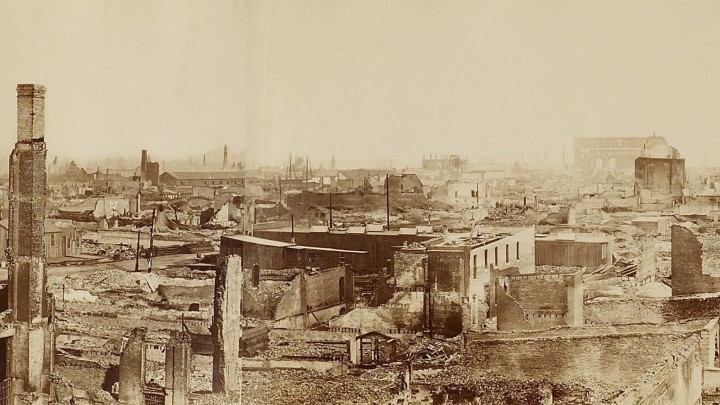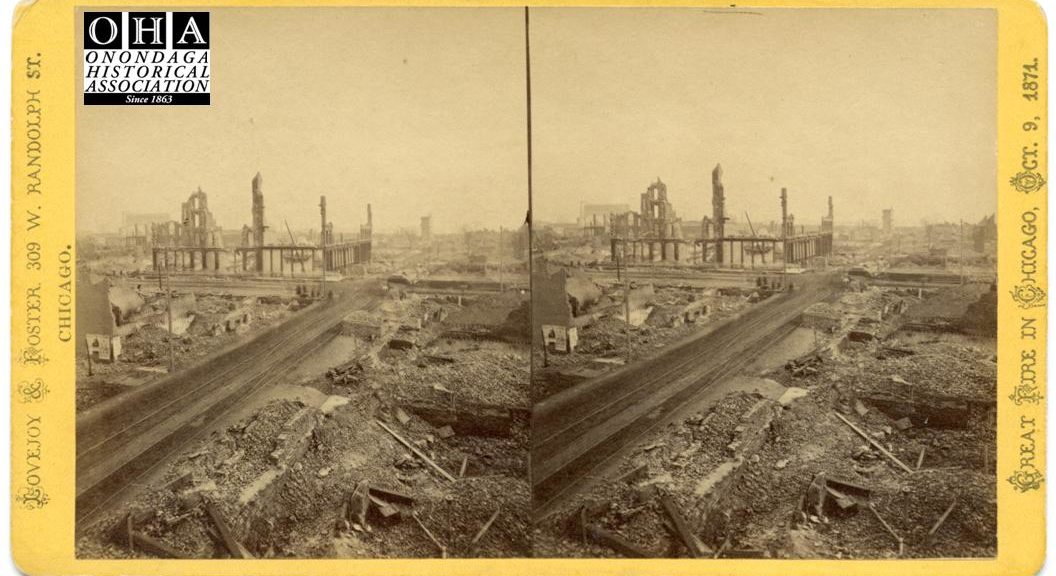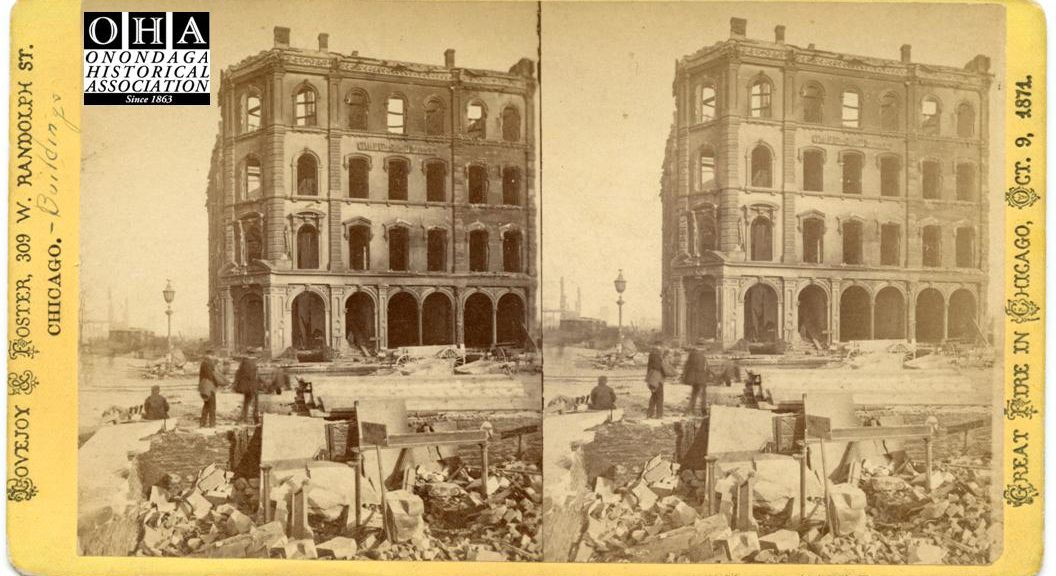
On the night of October 8th, 1871, a fire started in the barn of Patrick and Catherine O’Leary in Chicago, Illonois. The blaze quickly grew out of control and spread rapidly throughout the city. By the time it burned out two days later, the Great Chicago Fire had destroyed over three square miles of property, caused millions of dollars in damage, and left over 100,000 people homeless.
Cities all across the country sent monetary donations, clothing and food to the relief of the citizens. Syracuse residents sent $35,000 to help the victims of the fire. George Barnard, a renowned Civil War photographer from Central New York (living in both Oswego and Syracuse before the war), was living in Chicago at the time of the fire and took magnificent photographs of the devastation.
According to the History Channel, “In 1997, the Chicago City Council passed a resolution exonerating Catherine O’Leary, an Irish immigrant who died in 1895, and her cow.”
About George Barnard:
George N. Barnard was born on December 23, 1819 in Coventry, Connecticut to Norman Barnard and Grace Badger. His early years were filled with farm work, religious observances, and family activities. When his father died in 1826, his mother moved the family to central New York to live near relatives, and by 1828, the family was living in Auburn. Barnard moved with his sister and her husband to Nashville, Tennessee in 1833, and then later to Gallatin, Tennessee, where he spent several years.
By 1842 he had returned to New York State where he lived with family in Sauquoit. Barnard married nineteen-year-old Sarah Jane Hodges in 1843 and they had two children: a daughter named Mary Grace, and a son who died in infancy. Over the course of this influential photography pioneer’s career, he covered such widely varied events as the Civil War and the Chicago Fire, travel photography in Niagara Falls and Cuba, and the lives of sharecroppers in South Carolina. The photograph above captures Barnard at the height of his career in 1865.
After much time away, Barnard moved back to New York in 1880, following his daughter’s family to Henrietta. In 1881, he married his second wife, Emma Chapin Gilbert, who was his daughter’s mother-in-law. After moves to Ohio and Alabama, Barnard lived out his last years in the rural community of Cedarvale, NY, and maintained his interest in photography. Although he was over seventy years of age, he made portraits of family members and neighbors, using a curtain as a backdrop in a simple farmhouse studio. He also made class pictures of children posed on the steps of the nearby schoolhouse at the end of each school year, and as late as June 1898, Barnard made a class portrait of teachers and students at a school picnic on Otisco Lake. The picture to the left shows Barnard sometime in the 1890s, towards the end of his life. Barnard died quietly in the midst of a great snowstorm on February 4, 1902, and his wife died later that same year on December 24.
More about Barnard, via Smithsonian American Art Museum:
“A well-known daguerrean artist in Oswego, New York, George N. Barnard had opened a photography studio in Syracuse by 1854. He subsequently became affiliated with Mathew Brady’s gallery in Washington, D.C., and photographed Lincoln’s inauguration in 1861. As an official Union Army photographer during the Civil War, he was given two mules, a covered wagon, and an African-American driver to follow several military campaigns, most notably General William Tecumseh’ Sherman’s famous march in 1864 from Chattanooga to Atlanta. His reminisces of General Sherman, Ulysses S. Grant, and Joseph Hooker made interesting reading for patrons of Harper’s Weekly, Leslie’s, and other contemporary periodicals and were illustrated by line engravings of his photographs. Prompted by the success of Alexander Gardener’s Photographic Sketchbook of the War, Barnard published Photographic Views of Sherman’s Campaign in 1866. Including sixty-one photographs, a small volume of historical text, and several official campaign maps, the album weighed twenty pounds and sold for one hundred dollars.
Barnard made at least three photographs of the area around New Hope, Georgia, after the week-long battle in May 1864 between General Joseph Johnston’s southern forces and Sherman’s troops. He often focused on broken trees and ravaged ground, as well as other melancholy views, such as the Jones Memorial on the grounds of Bonaventure Plantation near Savannah. Barnard’s album presents a complex symbolic picture of the appalling looses suffered in this national conflict.”



